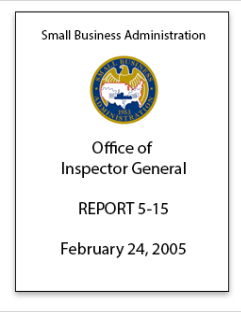The Issues
THE ISSUES
Through a combination of misguided Small Business Administration (SBA) policies, fraud, abuse, loopholes and a lack of oversight by the SBA, large firms are able to obtain small business procurement awards, and those awards are counted towards the 23% small business procurement goal.
1 - Large companies are using loopholes to win contracts set aside for small business
2 - The SBA falsifies the Federal government’s compliance with legal requirements
3 - Small businesses are defined as having 500 or less employees, a far too large number
4 - The SBA has essentially been “Closed” by successive administrations
The ASBL has been the one and only organization in American that has consistently opposed the diversion of Federal small business contracts to large businesses, the SBA’s fabrication of compliance with the government’s 23% small business contracting goal, cuts to the SBA’s budget and staff and the Pentagon’s blatant anti-small business Comprehensive Subcontracting Plan Test Program.
99% of all U.S firms have
less than 500 employees
1% of all U.S. firms have
more than 500 employees
97% of all Federal acquisitions are awarded
to less than 1% of all U.S. firms
AND YET...Small businesses are responsible for over 99% of all net new jobs.
The top 1% of all U.S. firms has not created even one net new job since 1980.
1
Big businesses, including many Fortune 500 companies use loopholes to win small business contracts
The SBA Office of Inspector General continued to reiterate the diversion of billions of dollars in Federal small business contracts to Fortune 500 firms, their subsidiaries and thousands of large businesses for several years.
When discussing the diversion of Federal small business contracts to large corporations, most people are amazed to find out that a foreign company with 26,000 employees with offices in 17 countries has been considered a small business in the past and has received Federal small business contracts.
However, the reality of the matter is that the problem is not one large company receiving Federal small business contracts, but dozens. We estimate that roughly $60 billion a year in Federal small business contracts is diverted to large corporations.
“One of the most important challenges facing the Small Business Administration (SBA) and the entire Federal Government today is that large businesses are receiving small business procurement awards and agencies are receiving credit for these awards.”
-Harold Damlin, Inspector General of the SBA
Continue Reading
On June 30, 2007 an SBA rule change mandated that all firms receiving Federal small business contracts must recertify their small business status every 5-years. However, prior to June 30 th companies were required to re-certify that status every 20 years. Through this loophole, large firms were able to acquire small companies with long-term — 10 to 20 year — small business contracts and maintain those contracts through that recertification period.
Despite the SBA’s efforts to reduce the recertification period, a 5-year recertification period still constitutes a significant loophole for large firms. We estimate that through this “grandfathering” policy , from 2007 to 2012 more than $300 billion dollars will be diverted from legitimate small businesses to some of the largest companies in the United States and Europe. That constitutes more than $60 billion a year.

-President Barack Obama
Compounding this issue is the Pentagon’s Comprehensive Subcontracting Plan Test Program (CSPTP).
The Pentagon’s CSPTP was adopted in 1989 under the guise of “increasing subcontracting opportunities for small businesses. The CSPTP has only two provisions.”
- The elimination of all penalties for the Pentagon’s largest prime contractors for non-compliance with Federal small business subcontracting goals.
- The elimination of all transparency on the specific goals and all information on the compliance with those goals.
Since 1989, the Pentagon has been “testing” whether or not the elimination of all transparency and all penalties for non-compliance with small business subcontracting goals will “increase subcontracting opportunities for small businesses” for over 32 years.
The Pentagon’s CSPTP is the most blatant example of the anti-small business attitude that the Federal government has demonstrated against the 30+ million small businesses. These small businesses are responsible for over 50% of the private sector work force, over 50% of the GDP, over 90% of all U.S. exports and over 99% of all net new jobs in America.
Lloyd Chapman and the ASBL have won more lawsuits than anyone in history against the government in through the Freedom of Information Act, to expose these fraudulent practices and names of the companies involved.
2
The SBA has falsified the Federal government’s compliance with the 23% small business contracting goal
Legitimate small businesses have been cheated out of trillions of dollars in Federal contracts and subcontracts by the long standing SBA policy of falsifying the Federal government’s compliance with the 23% small business contracting goal.
The SBA does this in two ways...
- First, by excluding the vast majority of Federal acquisitions from their calculations.
- Second, by including billions of dollars of Federal awards to Fortune 500 firms, their subsidiaries and thousands of recognizable large businesses, in the volume of contracts they claim were awarded to small businesses.
In 2019, the total Federal acquisition budget was over $1.5 trillion. To falsify compliance with the 23% goal, the SBA excluded over $1 trillion in Federal acquisitions and used an acquisition budget of less than $500 billion.
In reality, in FY 2019, legitimate small businesses likely received no more than 3% of the $1.5 trillion in Federal acquisitions. This fraudulent practice has taken place at the SBA for well over two decades.
There has been a long history of fraud and misrepresentation. The SBA’s Office of Inspector General in 1995 reported a “particular fraudulent practice” of companies continuing to falsely claim eligibility for small business set-aside contracts even after the SBA had prohibited them from doing so. SBA 5-09 Page 48.
A decade later, Report 5-16 from the SBA Inspector General cited a multiple award contract given “based on a false certification.” The company cited had claimed to be a small business and a manufacturer, but in fact was an affiliate of the actual manufacturer, a large business. SBA 5-16 Page 3.
3
A small business can have 499 employees? A lack of size standards costs true small businesses billions, the real backbone of our US economy and jobs.
98% of all firms have fewer than 100 employees
-US Census
There are more than 26 million small businesses in the United States. Almost all of them – 98% – have fewer than 100 employees. Yet, the basic standard for most industries is 500 employees.
Over the years, the Small Business Administration has revised its “size standard” – the numerical definitions for each industry. A recommendation to reduce the basic employee limit to 100 was halted by the SBA in July 2004, despite response comments that were overwhelmingly in support of the reduction.
The Small Business Administration issued the proposed rule change on March 19, 2004, stating its intention to reduce and simplify the number of size standards. The proposed rule would have helped millions of truly small businesses compete for government contracts. However, the proposal was withdrawn from pressure from some of the 34,000 firms currently recognized as small businesses who would have been reclassified.
The ASBL is committed to reducing the allowable size of small businesses so that truly small businesses have a fair opportunity to compete for government contracts.
“Small businesses are the backbone of the American economy. By working to change the definition of a small business for government contracts from 500 to 100 employees, Federal contracts specifically designed to ensure the success of American small business would go where they belong – to support Americans, not big companies dressed in sheep’s clothing.”
-Congresswoman Lynn Woolsey (D-CA)
4
There have been repeated efforts to close and minimize the power of the Small Business Administration
98% of all firms have fewer than 100 employees
-US Census
The SBA has essentially been closed by successive administrations that have slashed the annual operating budget of the SBA and have laid off most of the staff.
For 2021, the SBA’s annual operating budget is approximately $700 million. Over the last 30 years, the SBA’s budget has been cut more than any other agency in government.
In comparison, for 2021 the annual budget for the Commerce Department is over $10 billion. The Commerce Department represents less than 1% of all U.S. firms.
“Lloyd Chapman and the ASBL deserve recognition for the hard work they have done trying to bring an end to the diversion of Federal small business contracts to corporate giants.Their efforts, along with the passage of H.R. 2568 will provide a significant boost to our nation’s middle class economy.’
-Congressman Hank Johnson (D-GA)
Our Progress
600 large businesses have been stopped
Our information prompted their removal from SBA's database of small businesses.
Victorious
Victorious in reducing the SBA's Information Technology Value-Added Reseller size standard from 500 to 150.
Gathered overwhelming support
For the reduction in the size standard from 500 to 100 when the SBA sought public comment. The support ASBL received came from U.S. Chamber of Commerce, Small Business groups, and concerned small businesses across the country.
Won a series legal battles
Since 2004, the ASBL has won a series of federal lawsuits that have forced federal agencies to release information, which has shown that billions of dollars in federal small business contracts reported as going to small businesses actually wound up in the hands of some of the largest companies in the world.


